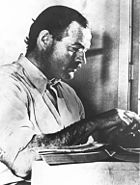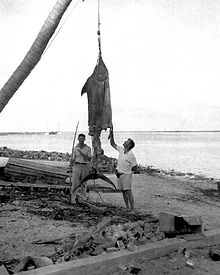
The Old Man and the Sea
Background to the schools Wikipedia
This content from Wikipedia has been selected by SOS Children for suitability in schools around the world. A good way to help other children is by sponsoring a child
| The Old Man and the Sea | |
|---|---|
 |
|
| Author(s) | Ernest Hemingway |
| Cover artist | "a" |
| Country | United States |
| Language | English |
| Genre(s) | Novel |
| Publisher | Charles Scribner's Sons |
| Publication date | 1952 |
| Media type | Print (hardcover and paperback) |
| Pages | 127 |
The Old Man and the Sea is a novel written by the American author Ernest Hemingway in 1951 in Cuba, and published in 1952. It was the last major work of fiction to be produced by Hemingway and published in his lifetime. One of his most famous works, it centers upon Santiago, an aging fisherman who struggles with a giant marlin far out in the Gulf Stream. The Old Man and the Sea was awarded the Pulitzer Prize for Fiction in 1953 and was cited by the Nobel Committee as contributing to the awarding of the Nobel Prize in Literature to Hemingway in 1954.
Plot summary
The Old Man and the Sea is the story of a battle between an old, experienced Cuban fisherman and a large marlin. The novel opens with the explanation that the fisherman, who is named Santiago, has gone 84 days without catching a fish. Santiago is considered "salao", the worst form of unlucky. In fact, he is so unlucky that his young apprentice, Manolin, has been forbidden by his parents to sail with the old man and been ordered to fish with more successful fishermen. Still dedicated to the old man, however, the boy visits Santiago's shack each night, hauling back his fishing gear, getting him food and discussing American baseball and his favorite player Joe DiMaggio. Santiago tells Manolin that on the next day, he will venture far out into the Gulf Stream, north of Cuba in the Straits of Florida to fish, confident that his unlucky streak is near its end.
Thus on the eighty-fifth day, Santiago sets out alone, taking his skiff far onto the Gulf Stream. He sets his lines and, by noon of the first day, a big fish that he is sure is a marlin takes his bait. Unable to pull in the great marlin, Santiago instead finds the fish pulling his skiff. Two days and two nights pass in this manner, during which the old man bears the tension of the line with his body. Though he is wounded by the struggle and in pain, Santiago expresses a compassionate appreciation for his adversary, often referring to him as a brother. He also determines that because of the fish's great dignity, no one will be worthy of eating the marlin.
On the third day of the ordeal, the fish begins to circle the skiff, indicating his tiredness to the old man. Santiago, now completely worn out and almost in delirium, uses all the strength he has left in him to pull the fish onto its side and stab the marlin with a harpoon, ending the long battle between the old man and the tenacious fish. Santiago straps the marlin to the side of his skiff and heads home, thinking about the high price the fish will bring him at the market and how many people he will feed.
While Santiago continues his journey back to the shore, sharks are attracted to the trail of blood left by the marlin in the water. The first, a great mako shark, Santiago kills with his harpoon, losing that weapon in the process. He makes a new harpoon by strapping his knife to the end of an oar to help ward off the next line of sharks; in total, five sharks are slain and many others are driven away. But the sharks keep coming, and by nightfall the sharks have almost devoured the marlin's entire carcass, leaving a skeleton consisting mostly of its backbone, its tail and its head. Finally reaching the shore before dawn on the next day, Santiago struggles on the way to his shack, carrying the heavy mast on his shoulder. Once home, he slumps onto his bed and falls into a deep sleep.
A group of fishermen gather the next day around the boat where the fish's skeleton is still attached. One of the fishermen measures it to be 18 feet (5.5 m) from nose to tail. Tourists at the nearby café mistakenly take it for a shark. Manolin, worried during the old man's endeavor, cries upon finding him safe asleep. The boy brings him newspapers and coffee. When the old man wakes, they promise to fish together once again. Upon his return to sleep, Santiago dreams of his youth—of lions on an African beach. The old man feels very unwell and also coughs up blood a few times towards the end of the story.
Background and publication
Written in 1951, and published in 1952, The Old Man and the Sea is Hemingway's final work published during his lifetime. The book, dedicated to Hemingway's literary editor Maxwell Perkins, was featured in Life magazine on September 1, 1952, and five million copies of the magazine were sold in two days. The Old Man and the Sea also became a Book of the Month selection, and made Hemingway a celebrity. Published in book form on September 1, 1952, the first edition print run was 50,000 copies. The illustrated edition featured black and white illustrations by Charles Tunnicliffe and Raymond Sheppard. The novel received the Pulitzer Prize in May, 1952, and was specifically cited when he was awarded the Nobel Prize in Literature in 1954. The success of The Old Man and the Sea made Hemingway an international celebrity. The Old Man and the Sea is taught at schools around the world and continues to earn foreign royalties.
No good book has ever been written that has in it symbols arrived at beforehand and stuck in. ... I tried to make a real old man, a real boy, a real sea and a real fish and real sharks. But if I made them good and true enough they would mean many things.
Hemingway wanted to use the story of the old man, Santiago, to show the honour in struggle and to draw biblical parallels to life in his modern world. Possibly based on the character of Gregorio Fuentes, Hemingway had initially planned to use Santiago's story, which became The Old Man and the Sea, as part of an intimacy between mother and son and also the fact of relationships that cover most of the book relate to the Bible, which he referred to as "The Sea Book." (He also referred to the Bible as the "Sea of Knowledge" and other such things.) Some aspects of it did appear in the posthumously published Islands in the Stream. Hemingway mentions the real life experience of an old fisherman almost identical to that of Santiago and his marlin in On the Blue Water: A Gulf Stream Letter ( Esquire, April 1936).
Literary significance and criticism
The Old Man and the Sea served to reinvigorate Hemingway's literary reputation and prompted a reexamination of his entire body of work. The novel was initially received with much popularity; it restored many readers' confidence in Hemingway's capability as an author. Its publisher, Scribner's, on an early dust jacket, called the novel a "new classic," and many critics favorably compared it with such works as William Faulkner's "The Bear" and Herman Melville's Moby-Dick.
Santiago as a Spaniard
"'Eyes the Same Colour of the Sea': Santiago's Expatriation from Spain and Ethnic Otherness in Hemingway's The Old Man and the Sea" focuses on the old man's national identity. Using baseball references, the article points out that Santiago was at least 22 years old when he moved from Spain to Cuba. "Born in Spain’s Canary Islands, Santiago moved to Cuba as a young man; this circumstance has a significant impact on his social condition." Santiago was old enough to have a Spanish identity when he immigrated, and the article examined how being a foreigner (and from a country that colonized Cuba) would influence his life on the island. Because Santiago was too poor to move back to Spain—many Spaniards moved to Cuba and then back to Spain at that time—he adopted Cuban culture like religious ceremonies, Cuban Spanish, and fishing in skiffs in order to acculturate in the new country. The dangerous hunt for the marlin was an effort to earn a place in the new community, something which had eluded him.
Religion as theme
Joseph Waldmeir's essay "Confiteor Hominem: Ernest Hemingway's Religion of Man" is a favorable critical reading of the novel—and one which has defined analytical considerations since. Perhaps the most memorable claim therein is Waldmeir's answer to the question—What is the book's message?
- "The answer assumes a third level on which The Old Man and the Sea must be read—as a sort of allegorical commentary on all his previous work, by means of which it may be established that the religious overtones of The Old Man and the Sea are not peculiar to that book among Hemingway's works, and that Hemingway has finally taken the decisive step in elevating what might be called his philosophy of Manhood to the level of a religion."
Waldmeir was one of the most prominent critics to wholly consider the function of the novel's Christian imagery, made most evident through Hemingway's blatant reference to the crucifixion following Santiago's sighting of the sharks that reads:
- "‘Ay,′ he said aloud. There is no translation for this word and perhaps it is just a noise such as a man might make, involuntarily, feeling the nail go through his hands and into the wood."
An unrealistic novel?
One of the most outspoken critics of The Old Man and the Sea is Robert P. Weeks. His 1962 piece "Fakery in The Old Man and the Sea" presents his claim that the novel is a weak and unexpected divergence from the typical, realistic Hemingway (referring to the rest of Hemingway's body of work as "earlier glories"). In juxtaposing this novel against Hemingway's previous works, Weeks contends:
- "The difference, however, in the effectiveness with which Hemingway employs this characteristic device in his best work and in The Old Man and the Sea is illuminating. The work of fiction in which Hemingway devoted the most attention to natural objects, The Old Man and the Sea, is pieced out with an extraordinary quantity of fakery, extraordinary because one would expect to find no inexactness, no romanticizing of natural objects in a writer who loathed W.H. Hudson, could not read Thoreau, deplored Melville's rhetoric in Moby Dick, and who was himself criticized by other writers, notably Faulkner, for his devotion to the facts and his unwillingness to 'invent.'"
Some critics suggest "The Old Man and the Sea" was Hemingway's reaction towards the criticism of his most recent work, Across the River and into the Trees. The negative reviews for Across the River and into the Trees distressed him, and may have been a catalyst to his writing of The Old Man and the Sea.


